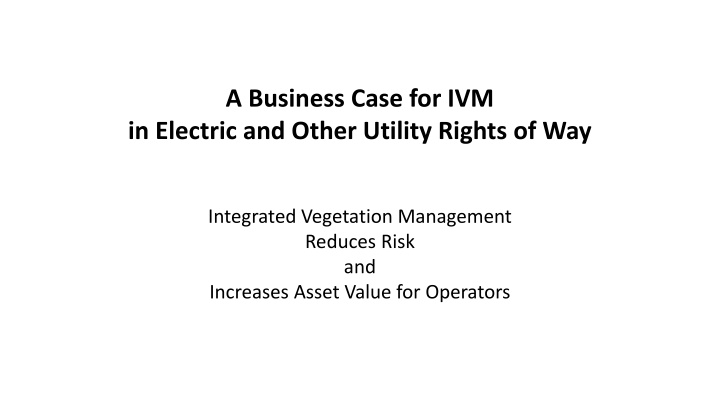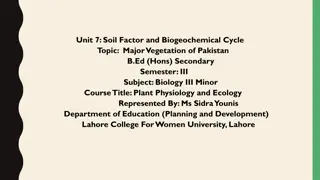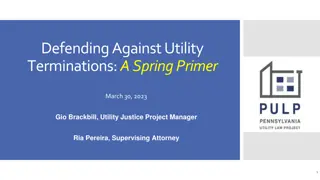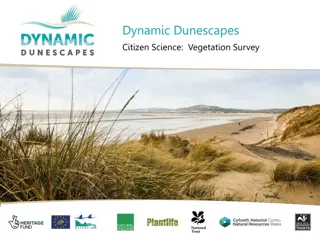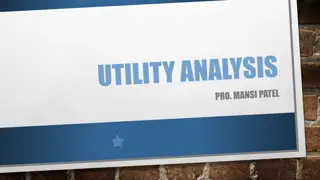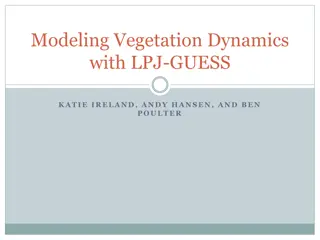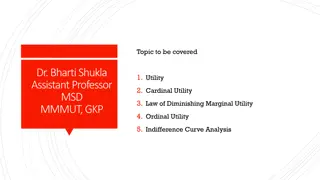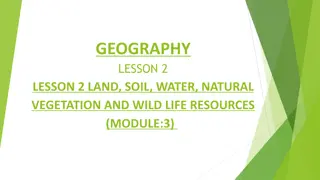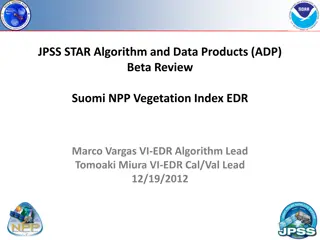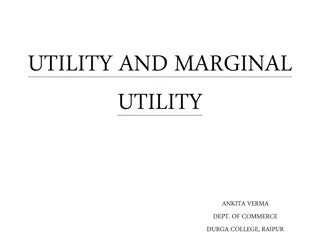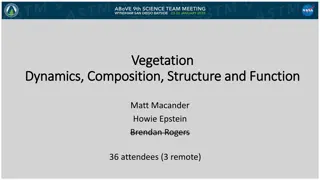Enhancing Utility Rights of Way with Integrated Vegetation Management
Integrated Vegetation Management (IVM) is a systematic approach that promotes low-growing plant communities to resist invasive tree species. It involves continual improvement through a cycle of information gathering, planning, implementation, and review. By employing IVM in utility rights-of-ways, operators can enhance safety, economic performance, regulatory compliance, and environmental outcomes, leading to improved stakeholder relations and employee satisfaction. Operational safety benefits include grid reliability by reducing vegetation encroachment, while economic benefits stem from cost savings in maintenance.
Download Presentation

Please find below an Image/Link to download the presentation.
The content on the website is provided AS IS for your information and personal use only. It may not be sold, licensed, or shared on other websites without obtaining consent from the author.If you encounter any issues during the download, it is possible that the publisher has removed the file from their server.
You are allowed to download the files provided on this website for personal or commercial use, subject to the condition that they are used lawfully. All files are the property of their respective owners.
The content on the website is provided AS IS for your information and personal use only. It may not be sold, licensed, or shared on other websites without obtaining consent from the author.
E N D
Presentation Transcript
A Business Case for IVM in Electric and Other Utility Rights of Way Integrated Vegetation Management Reduces Risk and Increases Asset Value for Operators
What is Integrated Vegetation Management? Integrated Vegetation Management (IVM): IVM is generally defined as the systematic practice of promoting compatible, stable, low-growing plant communities that will resist invasion by tall- growing tree species through the use of appropriate, environmentally sound, and cost-effective control methods. Adopted as ANSI A300 (Part 7) in 2018, IVM is the Industry Standard accepted by regulators, public agencies, Non-Governmental Organizations and academics.
IVM is a Process of Continual Improvement IVM can be viewed as a system based on a continuous cycle of information gathering, planning, implementing, reviewing, and improving vegetation management treatments and the related actions that a utility might undertake to meet its business and environmental needs.
Six Step IVM System Set Objectives Monitor & Quality Assurance Evaluate Site Define Action Thresholds Implement IVM Evaluate & Select Control Methods
Why Employ IVM? Employing IVM in energy rights-of-ways results in a variety of benefits: Increased Safety for the Operation Increased Economic Performance Increased Regulatory Compliance Improved Environmental Outcomes Improved Stakeholder Relations Increased Employee Satisfaction
Operational Safety Benefits of IVM Improves safety and reliability of the grid IVM maintains less vegetation encroachment, so infrastructure and facilities are easier to access, inspect and maintain, reducing costly power outages Long term maintenance will require less work at height and more ground based work thereby reducing worker exposure
Economic Benefits of IVM IVM is less expensive, long-term strategy Cost-benefit analyses and Net Present Value calculations As the ROW vegetation community transitions, utility companies spend less money maintaining the ROW through reduced need for mechanical controls (e.g., mowing) and more focused, selective chemical controls (e.g., herbicide application) Contributes to ESG and Investor Targeted profiles Creation of habitat supports biodiversity/sustainability goals
Regulatory Compliance Electrical faults from energized conductors to trees and other vegetation can result in significant interruptions, major outages to customers and penalties for not meeting reliability standards IVM improves both federal and state regulatory compliance FAC 003.4 FERC/NERC Reliability standards Public Utility Commissions Environmental Protection Agency (Federal and State) Wildlife statutes such as ESA, etc. Creates opportunities for voluntary conservation initiatives as wildlife habitat is created, protected and maintained, e.g., CCAA for monarch butterfly
Environmental Benefits of IVM IVM creates stable plant communities, and if done with intention it creates compatible habitat that will provide: Early successional habitat for many species Nesting and perching sites for raptors Rare plant refugia Nesting and foraging sites for edge adapted species Microclimates for amphibians and reptiles Botanically diverse habitat for pollinators and other invertebrates Greater biodiversity Wildlife corridors Reductions in stormwater run-off Increased carbon sequestration Improved air quality
Stakeholder Relations Benefits of IVM IVM creates a positive story and improves relationships with stakeholders, investors, employees and customers: Improves public relations and contribute to public acceptance or buy-in for projects Public approval of new ROWs helps facilitate regulatory approvals Customers benefit from lower costs and improved system reliability Increases engagement with community and neighboring landowners Provides opportunities to partner with civic & community groups Creates green spaces in urban community; social and environmental justice concerns Reduces wildfire risk through fuel load management and creation of firebreaks
Employee Engagement Benefits of IVM IVM engages employees in creating value for the organization and society because it: Requires employees obtain and provide greater levels of expertise Involves employees in developing and maintaining long term solutions with a broad range of benefits Employees play an active role in contributing to larger ESG/corporate goal Engages employees, partners, and others in conservation Provides opportunities to be involved with civic & community groups on positive outcomes
How to Realize the Benefits of IVM Executive buy-in and support Regulatory support and approval Change in Funding Considerations Modify/update specification and program documentation Re-train and re-orient the workforce In house staffing Contractors
Executive Buy-In and Support IVM is the least costly and most beneficial ROW vegetation management strategy Integrated approach projected savings 48% over 15-20 years (John Goodfellow 2018 The Cost Efficiency of IVM ) Reduction in management inputs, direct and indirect costs Lower risk of vegetation encroachment between IVM treatments Achieve objectives of safety, reliability, regulatory compliance, environmental benefits, business and investor performance
Regulatory Support and Approval Update required regulatory filings with program plans Explore rate recovery mechanisms Improved reliability Sustainability enhancements Educate regulators on benefits of IVM to gain support Biodiversity Environmental stewardship Improved business efficiencies Social and governance impacts
Funding Considerations Successfully implemented, IVM changes the approach to managing the right of way from risk management to asset management. It typically requires an up front, capital investment Net present value (NPV) and net present costs (NPC) calculations show positive results Once initiated, the process must be continued in order to maximize the benefits, however costs will decrease over time Aligns with and promotes Corporate strategic objectives
Program Documentation Incorporate IVM processes and implementation plan in contractor specification and program documentation Review contracts and contractor specifications incorporate IVM and compatible species management standards, metrics, and incentives Develop & incorporate elements of a long-term vegetation management plan Develop IVM and compatible species training materials for Utility Vegetation Management Specialists, Work Planners & Contractors
Workforce Considerations Re-train and re-orient the workforce In house utility vegetation management specialists Contractors Consider additional resources and expertise required to implement IVM and compatible species management Expand the scope of work and allotted time of work planners to write prescriptions account for IVM and compatible species Create job descriptions (i.e., Roles, Responsibilities, Required Level of Knowledge, etc.) & rebrand as applied science where possible Attract, train and retain herbicide contractors and link proficiency in plant identification to incentives, promotions and compensation
Appendices Examples and Case Studies Science, Research and Citations IVM Process Flow Chart
Examples and Case Studies John Goodfellow s Cost of IVM Cost-benefit Analysis Summary for the CCAA CCAA Enrollment Timing Document EPRI s Ecosystem Services Decision Tree - Determining the Business Case (pg 23) EPRI s Business Case for Sustainability Tree Fund s The Cost of Deferred Maintenance
Science Research and Sources Cited https://www.epa.gov/pesp/benefits-integrated-vegetation-management-ivm-rights- way#economic http://www.rowstewardship.org/resource_pdfs/ivm_framework.pdf https://www.gotouaa.org/wp-content/uploads/2019/06/Final-Report-Cost- efficiency-of-IVM.pdf http://rightofway.erc.uic.edu/wp-content/uploads/2018/05/5B1EPRI-Ecosystem- Services-Decision-Tree-1.pdf
IVM Process Flowchart Order of processes may vary or occur concurrently 21
